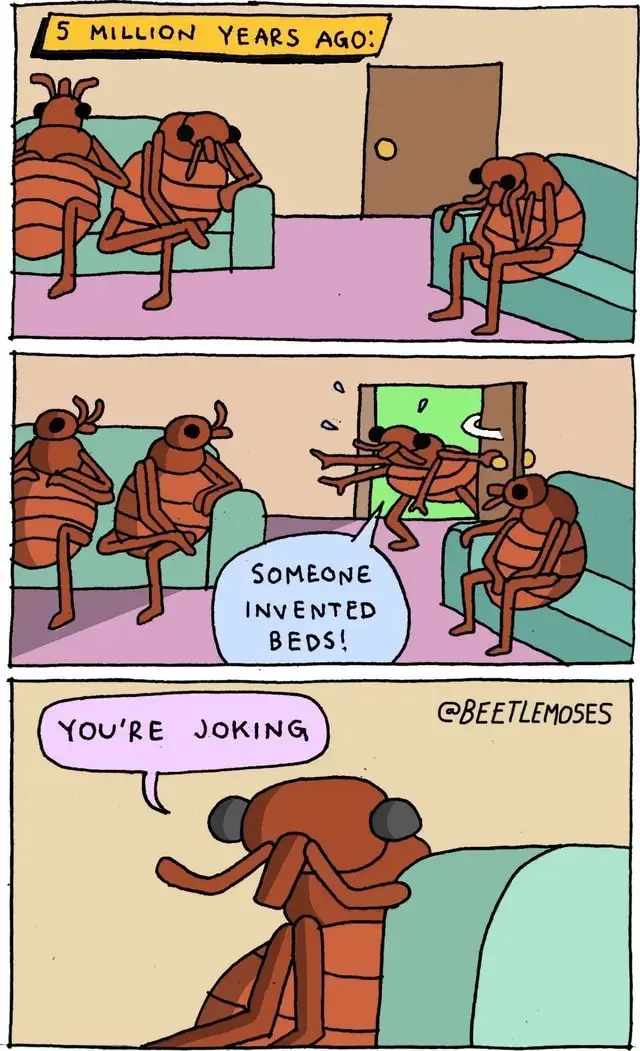Famous last words.
- 0 Posts
- 49 Comments

 4·5 days ago
4·5 days agoWorked in an italian restaurant for a few years. IIRC our lasagna generally had pork sausage, yellow squash, onions, bell peppers, black olives and a bunch of the usual cheeses. Probably had some other veggies too but it’s been a while since I worked there.
It was good lasagna.

 9·5 days ago
9·5 days agoTo add, that’s the only context I’ve ever heard it used in when working in restaurants (to convey that we can’t sell or offer anymore of a thing). If someone order a lasagna with no olives, no one will say “lasagna, 86 olives”.
Thanks for confirming. I’m glad you mentioned it, cause it’s so important for teachers to create a learning environment that students want to learn from.
My schooling was made a lot worse by teachers that had the “punish cheaters” kind of mindset, and it’s a big part of why I dropped out of highschool.

 41·8 days ago
41·8 days agoGet a hormone blood panel done, it can check your cortisol.
I had one done a few weeks ago and (big surprise) my cortisol is basically non existent.
The implication I gathered from the comment was that if students are resorting to using chatgpt to cheat, then maybe the teacher should try a different approach to how they teach.
I’ve had plenty of awful teachers who try to railroad students as much as possible, and that made for an abysmal learning environment, so people would cheat to get through it easier. And instead of making fundamental changes to their teaching approach, teachers would just double down by trying to stop cheating rather than reflect on why it’s happening in the first place.
Dunno if this is the case for the teacher mentioned in the original post, but the response is the vibe I got from the comment you replied to, and for what it’s worth, I fully agree. Spending time and effort on catching cheaters doesn’t help there be less cheaters, nor does it help people like the class more or learn better. Focusing on getting students enjoyment and engagement does reduce cheating though.

 2·20 days ago
2·20 days agoWiki page for more info cause you beat me to the fun fact: https://en.wikipedia.org/wiki/Luffa

 2·3 months ago
2·3 months agoMonster Hunter Generations Ultimate (released 2018 outside of JP) had a ton of dlc quest unlocks and they were all totally free. It’s proving difficult to find a proper separated list of exactly how many, but here’s a google doc that lists ~200 quest related equipment unlocks, the vast majority of which are dlc: https://docs.google.com/spreadsheets/d/1hlBLacFYxdh83a-GkxYnsIF6nH7huP_H2aI4APRGicg/edit?gid=408012748#gid=408012748
Something noteworthy is that’s just quests for equipment. In contrast, there’s only 37 event quests (all event quests are free) in Rise that offer any unique item reward, and 23 of those quests give equipment.
Giving a very conservative estimate with that all in mind, I think it’s safe to say that GU had a good five times more free dlc rewards than Rise does.

 4·3 months ago
4·3 months agoJust wanna throw it out there that the Monster Hunter series is a perfect example of in game free content becoming microtransactions in just a few years.
Old MH games had all cosmetic items as free event quest rewards, where you’d get a unique and fun battle to play, and a cosmetic reward for winning. No paid DLC even available to buy. MH Rise (the newest game) has 221 paid cosmetic items listed on their site. That number is not including bundles, soundtracks, character edit vouchers, or the expansion (Sunbreak) itself.
$60 game, $40 expansion, and 200+ paid cosmetics that would instead be free in earlier games in the series.
It’s also noteworthy that listening to audio via phone microphones is terrible. Speech to text works like shit, and the expectation is that people need to speak as plainly as possible, and over a long period of manual adjustments will it get to a point where it’s halfway usable.
Ever gotten a pocket dial from someone? Can you hear anything that even resembles speech over the rustling of fabric? Seems like a wild leap to assume that corpos are listening in on random audio, when the software designed around people specifically speaking plainly and clearly to their phone barely works at all.
Plenty of things to be concerned about with info privacy, but it’s important to recognize the limitations of hardware.

 19·3 months ago
19·3 months agoJokes on them, my TV can’t connect to the internet anymore because of the the bloat added by Roku in automatic updates.
I think you could do that with openrgb and both the visual map plugin (same link as I posted before) and hardware sync. I haven’t specifically tried it, but from what I have done, I think it’s quite doable.
Use visual map to create individual control over numpad lights (as opposed to keeping them grouped up with the rest of the keyboard, which gives less options), and then in theory you should be able to map any temp reading to any key that you’ve separated from the group.
There’s more than just temps as options too. Poking through, I saw stuff like power draw and clock speeds, ram usage/availability, and ethernet throughput. Could be fun to map stuff like that, though likely that would have less utility in most situations.
Responding to temperatures is useful but I think that might require a little more scripting.
Hardware Sync Plugin can help with this: https://openrgb.org/plugins.html
Adds a new tab in openrgb where you can set a hardware item, a light output and then make a color (and brightness maybe?) gradient by just inputting a few numbers and colors, and openrgb will do all the fading in between. I have my GPU temp set to my motherboard light. Compared to my rainmeter setup, it’s easier to get a general vibe at a glance and more eye catching if it gets unusually hot.
RGB ram and other PC internals are definitely a scam, but you can put them to use if you already have them.
I use OpenRGB (an rgb program) to set my built in motherboard rgb light to be a color gradient based on my GPU temperature (ie: minimum temp is cyan, and fades green/yellow/red for higher temps). Not distracting cause it doesn’t ever have major temperature changes in a short time, and it’s pretty convenient as a general monitor when I’m playing games.
Definitely not a selling point for rgb internals, but a neat usage if you already have it.
I love rgb on my keyboard though. Color coded keys are a godsend for me to break up letters/numbers/punctuation.
deleted by creator
It’s a catchy song. Here’s an acapella cover by Home Free:







Please understand how small an elevator is, and how big fireball is. Your party is begging you.